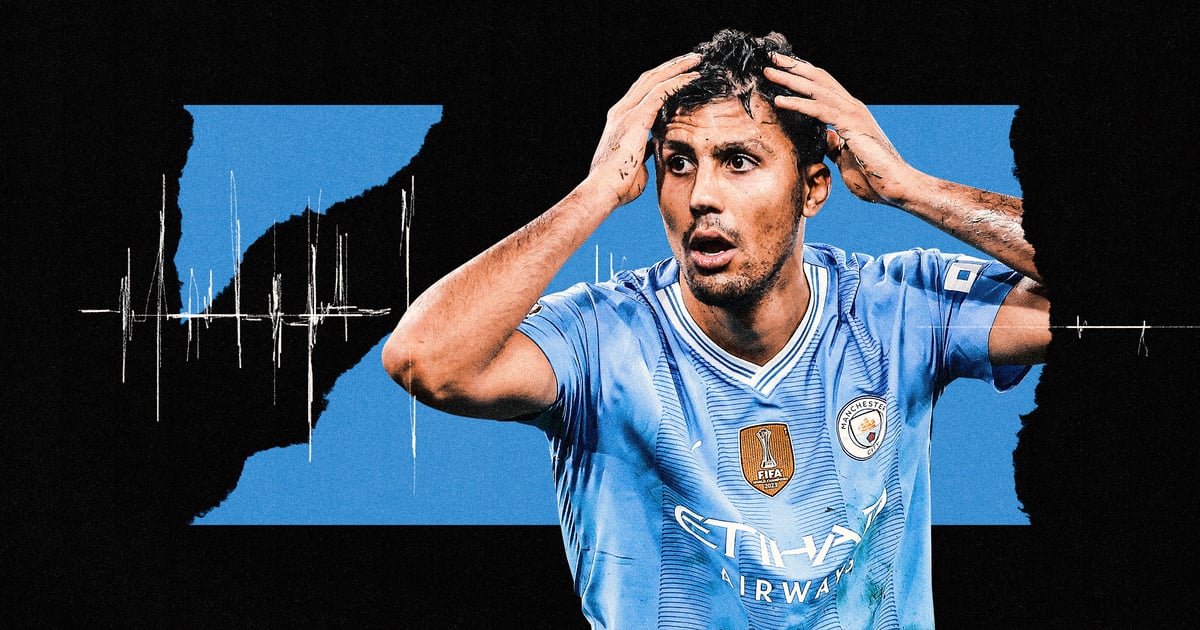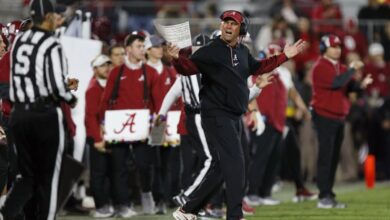Are Premier League players really going on strike?

It is the week that Manchester City launches a new attack on the Champions League, against the backdrop of a legal battle with the Premier League. Yet Rodri, the club’s star player, managed to give the conversation an unexpected twist on Tuesday.
A question about the increasing demands on Europe’s elite players drew a sharp response. “We are close (to a strike),” Rodri told reporters at a press conference previewing City’s clash with Inter. “It is the general opinion of the players and if it continues like this we have no other option.”
The debate over the football calendar has been going on for some time, but Rodri’s words felt like a significant moment. One of the Premier League’s most talented stars, a leading contender for the Ballon d’Or award next month, willingly made it known that strikes have become a consideration for him and his colleagues.
A real threat or an empty bluff? The Athletics assesses how realistic a player strike is in the ongoing battle to be heard.
Why are players like Rodri angry?
Footballers, at least at the height of the sport, now feel that too much is being asked of them. Expanded competitions have limited the opportunity for rest and ensure that established international stars regularly exceed the 55-game-per-season limit recommended by FIFPro, the global players’ union.
This season has only heightened the doubts. A new format in the UEFA Champions League adds two extra group matches to a participating club’s schedule, and in the summer FIFA launches its new Club World Cup between 15 June and 13 July.
The 2024-25 season began with Rodri and his Manchester City team-mates theoretically set to make 75 appearances for club and country. “It’s too much,” Rodri said on Tuesday. “It’s not all about money or marketing. It’s about the quality that is shown. When I’m not tired, I perform better.”
Rodri pointed in a few short sentences to the nuclear button in the players’ arsenal. There has long been a belief that their views are not being heard, a feeling that has been entrenched by the creeping expansion overseen by both UEFA and FIFA. Pre-season and end-of-season tours that involve a lot of travel are also an uncomfortable norm for players to swallow.

Rodri made 50 first-team appearances in six competitions for Manchester City last season (Justin Tallis/AFP via Getty Images)
However, over the last six months there has been an orchestrated response.
Two of Europe’s largest players’ unions, England’s Professional Footballers’ Association (PFA) and France’s Union Nationale des Footballeurs Professionnels, filed a lawsuit against FIFA in June, challenging the lawfulness of the governing body’s “unilateral” decision on the international football fixture list.
A month later, it was the European leagues, which represent professional football in 30 European countries, including the Premier League, which, together with La Liga and FIFPro Europe, filed a formal complaint with the European Commission against FIFA.
The new Club World Cup, said FIFPro, was the “straw that broke the camel’s back” and deep battle lines have now been drawn, with players at the heart of the fray. Enough, they argue, is enough.
How does a strike work in practice?
Rodri could have suggested that strike action was “close”, but the train is still a few stops away from that point. This would have to be coordinated through the PFA or FIFPro and would be considered a last resort if all negotiations with stakeholders fail.
The PFA, the only players’ union in English football, should in theory ask its nearly 5,000-strong base whether they support a strike, after which a majority of voters would have to back the strike for it to go ahead.
Any leagues affected, whether it be the Premier League, the English Football League, the Football Association, UEFA or FIFA, also have the ability to take legal action to block planned strikes.
“We really tried our best to engage with the relevant stakeholders,” Maheta Molango, the PFA CEO, told The Athletic FC Podcast last week. “So we tried to do our best to reach a diplomatic solution — legal action is always a defeat for everyone.
“But sometimes, when adults can’t come to a solution, you need a third party to decide for you.”

PFA director Maheta Molango (Steven Paston/PA Images via Getty Images)
Has this ever happened before in English football?
Go back to November 2001 and there was a very real danger that the biggest names in English football were going to put down their tools. The PFA had grown weary of negotiations with the Premier League, which wanted the traditional cut from domestic broadcasting deals sent to the union to be reduced from five per cent to two.
Three months of discussions had passed without an agreement, leading to a strike vote. Ninety-nine percent of the players were in favor of a boycott of a televised match. A date was even set for the strike action: December 1. Gordon Taylor, head of the PFA, claimed that Manchester United manager Sir Alex Ferguson and players including Roy Keane, Gary Neville and Ryan Giggs supported their position.
There were legal threats and injunctions, but the strike was eventually averted after eight hours of talks between the Premier League and PFA in Manchester. Taylor did not get everything he wanted, but the offer of £17.5 million ($23 million at current rates) was ultimately deemed satisfactory.

Gordon Taylor announced in 2001 that more than 99 percent of PFA members had voted in favor of strike action (Phil Noble – PA Images/PA Images via Getty Images)
And delve deeper into the history of English football, all the way back to 1960, and you come to a much more significant moment. The PFA, led by Jimmy Hill, attempted to abolish the £20-a-week wage limit for players, relying on the threat of strikes to finally force the FA and the Football League to concede in 1961.
What about in other countries or other sports?
In the US, strikes are much more common because the power of the players’ unions is much more palpable there.
The National Basketball Association (NBA) faced three lockouts in the late 1990s and another, five-month-long lockout in 2011. That was the same year the National Football League (NFL) had one of its own, when players and owners failed to reach an agreement on a revised collective bargaining agreement.
Major League Baseball has yet to experience a lockout in 2022, the ninth in the organization’s history. And then there’s the National Hockey League (NHL), another one well-versed in tense negotiations, player power and unblinking owners.
However, comparisons with European football are not so important. An elite player in England will play in matches organised by the Premier League, EFL, FA, UEFA and FIFA in a season and the presence of multiple stakeholders will always complicate negotiations over the welfare of a union’s members.
Which leagues are vulnerable to a player strike?
That’s the big unknown, but what we can be certain of is the strength of the relationship between the PFA and the Premier League at the moment. While the two were at loggerheads 23 years ago, with Taylor clashing with Richard Scudamore, the two have become closely linked in recent times. Don’t take it as a coincidence that the PFA launched a lawsuit against FIFA in the same summer months that the Premier League helped form a separate case.
The PFA – and by extension FIFPro – have no problem with domestic fixtures, which remain largely unchanged. There is also sympathy for the FA and EFL, whose competitions have been squeezed to the point of forced reform in the modern era. It therefore seems unlikely that a strike threat would target such a player.
Relations between the PFA and UEFA are more harmonious because of the greater consultation. Could FIFA be the target?
FIFA, which controls the international calendar, has been the target of much anger following the introduction of a revamped Club World Cup. Its defence may be well-versed and robust, pointing out that the matches it organises are a fraction of a player’s workload, but its unions have made their displeasure clear.
The Club World Cup is also the competition struggling to secure broadcast and sponsorship deals for next summer, and feels like the softest target for players who want to make their feelings known.

GALLING DEEPER
One year to go until the Club World Cup in the United States. What will happen?
How likely is a strike?
The easiest move would be to dismiss Rodri’s comments as hot air, but the concerns are too deep-seated. Without meaningful change to the calendar, unions insist, there will come a time when players will have to take a stand.
What that will look like and when it will come are questions that are not easy to answer. The workload issues are creating multiple stakeholders who want more and the next challenge will be how to get the toothpaste back in the tube.
Ultimately, the players’ unions want a more prominent seat at the boardroom table. That’s why they’ve taken legal action against FIFA, a move to make their voices heard and reduce the demands placed on their members.
The initial case against FIFA, filed in June at the Brussels Commercial Court, is likely to reach the European Court of Justice sometime next year, with the final decision determining where all parties go next. The players’ unions hope this will mean a watering down of FIFA’s powers over the international match calendar, leading to long-term reform.
Strikes, regardless of their likelihood, would remain problematic. It is worth ending with a comment from Stephen Taylor-Heath, head of sports law at JMW Solicitors, who spoke to The Athletics in June.
“It’s really about issues of employment law between players and clubs,” he said. “There’s always been an uneasy alignment between employment law and football.”
And maybe it will also become a little less direct.
(Top photo: Getty Images. Design: Dan Goldfarb)




